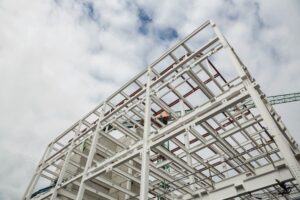
How to Integrate Passive Fire Protection Systems with Industrial Building?
The integration of passive fire protection systems into industrial buildings is an important part of modern construction.
The purpose of these systems is to contain and slow the spread of fire, ensuring the safety of both personnel and property. This critical task can be expertly handled by VMS Consultants, recognized as the top industrial Project Management Consultant in India, ensuring optimal safety and compliance.
This article outlines the importance of PFP, key considerations for its integration, and its benefits.
Understanding Passive Fire Protection
Passive fire protection involves the use of building components to control or prevent the spread of fire and smoke. Unlike active fire protection systems, such as sprinklers and alarms, PFP systems do not require activation. They are built into the structure of the building and work continuously to safeguard against fire hazards.
Key Components of Passive Fire Protection
Fire-Resistant Walls and Floors: These barriers are designed to withstand fire and prevent it from spreading from one area to another. They are typically made from materials like concrete, gypsum, and fire-resistant glass.
Fire Doors: Specially designed doors that can withstand high temperatures and block fire and smoke. They are essential for compartmentalizing a building and providing safe escape routes.
Fireproofing Materials: These are applied to structural elements such as steel beams and columns to maintain their integrity during a fire. Common fireproofing materials include intumescent coatings, cementitious coatings, and fireproof boards.
Compartmentalization: Dividing a building into fire-resistant sections helps to contain a fire and prevent it from spreading. This includes the use of firewalls, fire barriers, and smoke curtains.
Steps to Integrate Passive Fire Protection into Industrial Buildings
Initial Design Phase: Incorporating PFP elements during the design phase is crucial. Architects and engineers must collaborate to ensure that fire protection systems are seamlessly integrated into the building’s architecture.
Material Selection: Choose appropriate fire-resistant materials for construction. This includes selecting fire-rated walls, doors, and coatings that meet the required standards.
Regulatory Compliance: Ensure that all PFP systems comply with local building codes and fire safety regulations. In India, adherence to the National Building Code (NBC) is mandatory.
Installation: Proper installation is critical for the effectiveness of PFP systems. It’s important to work with experienced contractors who understand the intricacies of fire protection.
Regular Maintenance and Inspection: Passive fire protection systems require regular maintenance to remain effective. This includes inspecting fire doors, checking the integrity of fireproofing materials, and ensuring that compartmentalization elements are intact.
Benefits of Integrating Passive Fire Protection
Enhanced Safety: PFP systems provide an additional layer of safety by containing fires and giving occupants more time to evacuate. This can significantly reduce injuries and fatalities during a fire.
Minimized Property Damage: By containing fires to specific areas, PFP systems help to minimize damage to the building and its contents. This can lead to lower repair costs and reduced business interruption.
Compliance with Regulations: Meeting fire safety regulations is essential for any industrial facility. Integrating PFP systems ensures compliance and avoids potential fines or legal issues.
Insurance Benefits: Many insurance companies offer lower premiums for buildings with robust fire protection systems. This can lead to significant cost savings over time.
Challenges and Solutions in Implementing PFP
Cost Concerns: One of the main challenges in integrating PFP systems is the associated cost. However, the long-term benefits in terms of safety and reduced damage often outweigh the initial investment.
Complexity of Installation: Installing PFP systems can be complex, especially in existing buildings. Retrofitting these systems requires careful planning and execution to ensure effectiveness.
Ongoing Maintenance: Ensuring regular maintenance and inspection of PFP systems can be challenging. Establishing a routine maintenance schedule and employing trained personnel can address this issue.
Conclusion
Adding passive fire protection systems to industrial buildings is an important step toward improving fire safety. The risks associated with fire-related incidents can be significantly reduced by understanding PFP, implementing best practices, and maintaining these systems.
For expert guidance on integrating passive fire protection systems into your industrial building, trust VMS Consultants, Top industrial Project Management Consultant in India. VMS Consultants has a proven track record of providing Engineering Architecture & Project Management Services across a range of industries.
Contact us today to explore how we can help you enhance fire safety in your facility.





